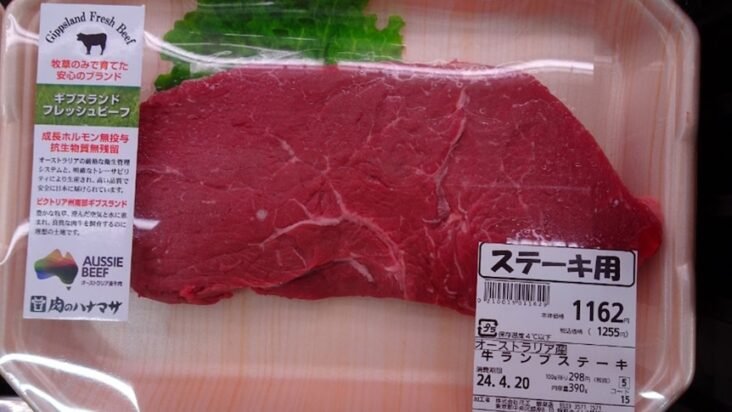
On a recent visit to Japan, a New South Wales farmer was shocked to find Australian beef selling in Tokyo for less than you can find it in Coles and Woolworths.
Andrew Dunlop runs cattle on his property in southern New South Wales and has spent his career working in the red meat industry, including 15 years in Japan.
Last month, he returned to Japan to find Australian cubed beef for sale at $18.35 a kilogram, around $2 to $4 a kilo cheaper than in major Australian supermarkets.
In Australia, Coles cubed beef is currently listed online for $22 a kilo, while a Woolworths rump steak is listed online for $28 per kilo.
Mr Dunlop said the meat he saw on sale in Tokyo was from the Hanamasa retail network, which has been described by some industry outlets as a “discount retailer”.
He said he was surprised that exporters could buy meat in the same market as the big Australian supermarkets, absorb the cost of international shipping and a 25 per cent import tariff, and still be comparable in price to the Australian market.
“I could see finely sliced product that would be equivalent to our stir fry product retailed in Australia,” he said.
“And I saw casserole or cubed product for what they do, which is a beef curry.
“I saw a rump steak and they were all seemingly pretty competitive with what we would be paying here.”
Mr Dunlop says it’s another sign of concentrated supermarket power and increased profit margins from supermarkets.
“The Japanese retail industry is not concentrated like it is here,” he said.
“Any individual retailer in Japan probably has at most a 10 per cent share of the market, although there will be some regional differences.”
John Gunthorpe, chair of the Australian Cattle Industry Council, said Australian meat was well trimmed and presented without much fat or sinew.
“The prices and the quality of presentation of the meat are far better than anything that we get here in Australia,” he said.
Pressed on whether it was a fair comparison to the beef in Australian supermarkets, Mr Gunthorpe said it was.
“It’s beef off the same farms,” he said.
“The real concern is the level of profit that Coles and Woolies are making in the domestic market relative to the profit that’s being made by the Japanese in Tokyo.”
Nationals leader David Littleproud said Australian major supermarkets are to blame.
“If they’re getting imports into Japan cheaper than what you’re paying at the supermarket, it points directly to the supermarkets because all that meat that goes to Japan is processed here,” he said.
“It’s processed with the same labour, the same cost, but actually the extra cost of getting to Japan should be factored into it — it shows that there is gouging.”
Industry analysts say there’s more to the story
Australian beef exports to Japan are very important for Australian farmers and Japanese consumers.
Around 70 per cent of Australian meat is exported around the world, and in 2022 Japan was Australia’s largest export market.
Tim Jackson, global supply analyst for Meat and Livestock Australia, said Australian beef has to compete with product from US and local cattle in Japan.
“A like for like comparison at one particular point in time is sometimes going to be a bit misleading without also considering the slightly different cuts sent to export and shifting exchange rates, which can also affect the retail price,” he said.
Agriculture industry analyst Matt Dalgleish, director of Episode 3, said another factor leading to cheaper prices in Japan is the more sophisticated and fragmented retail environment which serves a population of 125 million people.
“I think there’s a reason why we have in Australia only a handful of banks, a handful of airlines, a handful of superannuation funds, a handful of retailers — it’s because we do have a small population.”
How do you tell if supermarkets are price gouging?
According to Mr Dalgleish, one way to get a better sense of margins from processors and retailers would be legislate US-style transparency to the supply chain.
“The type of information that is legislated in America, they have a much more open and transparent market,” he said.
“From the farm gate all the way through the processing to the consumer end.
“You can see where the money is being made and see what kind of margins are out there.
“In Australia that’s not the case — maybe that’s where the focus should be.”
However, Mr Dalgleish said that increased transparency on the domestic front would also give our international competitors a clearer picture and possible advantage in export markets.
Supermarkets reject price gouging claims
A spokesperson for Woolworths said in a statement it was “not really possible to make a like for like comparison between Australia and Japan”.
“Australia produces beef across a very broad quality spectrum,” the spokesperson said.
“Woolworths purchases premium cattle to a very tight quality specification, quality which is independently certified through the Meat Standards Australia program.
“In none of the pictures of the Japanese products is this certification visible.”
Coles have previously rejected claims they are price gouging, saying food inflation was the cause of price increases, and that its profit margins were steady.
The Australian Competition and Consumer Commission (ACCC) is looking into claims of price gouging by the major supermarkets, and will report later in the year on price-setting practices.



